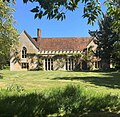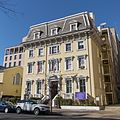Clergy house

A clergy house is the residence, or former residence, of one or more priests or ministers of a given religion.[1] Residences of this type can have a variety of names, such as manse, parsonage, rectory, or vicarage.
Function
[edit]A clergy house is typically owned and maintained by a church, as a benefit to its clergy. This practice exists in many denominations because of the tendency of clergy to be transferred from one church to another at relatively frequent intervals. Also, in smaller communities, suitable housing is not always available. In addition, such a residence can be supplied in lieu of salary, which may not be able to be provided (especially at smaller congregations).[2]
Catholic clergy houses in particular may be lived in by several priests from a parish. Clergy houses frequently serve as the administrative office of the local parish, as well as a residence. They are normally located next to, or at least close to, the church their occupant serves.
Partly because of the general conservation of churches, many clergy houses have survived and are of historic interest or importance. In the United Kingdom, the 14th-century Alfriston Clergy House was the first property to be acquired by the National Trust. It was purchased in a state of near ruin in 1896 for £10, the vicarage having moved elsewhere long before.[3]
In some countries where the clergy houses were often rather grand, many of them have now been sold off by the churches and replaced by more modest properties.[4] Numerous clergy houses have been acquired by families for use as private homes. Others have been adapted as offices or used for various civic functions. In many villages in England, the former clergy house is called the "Old Vicarage" or the "Old Rectory". In Scotland, a former clergy house may be known as the "Old Manse".
Nomenclature
[edit]There are a number of more specific terms whose use depends on the rank of the occupant, the denomination, and the locality. Above the parish level, a bishop's house was traditionally called a "Bishop's palace", a dean's residence is known as a deanery, and a canon lives in a canonry or "canon's house". Other clerical titles have different names for their houses.[5]
A parsonage is where the parson of a church resides; a parson is the priest/presbyter of a parish church. A rectory is the residence of an ecclesiastical rector, although the name may also be applied to the home of an academic rector (e.g., a Scottish university rector), or other person with that title. In North American Anglicanism, a far greater proportion of parish clergy were (and still are) titled as rector than in Britain, so the term rectory is more common there.[6]
The names used for homes of ordinary parish clergy vary considerably and include the following:
- The Anglican Communion uses the terms vicarage or (more informal and old-fashioned) parsonage, and rectory if appropriate.
- Roman Catholics use the terms priory, clergy house, parochial house (mostly in Ireland), chapel house (in Scotland), presbytery, and rectory (especially in Massachusetts) if appropriate. In the Philippines, the term convent is used, a direct calque of the Spanish convento. An ecclesiastical residence, sometimes called a presbytery, is the residence of a cleric in their diocese or parish.[7]
- Manse (cognate with mansion) is a Scottish term that is used in Scottish Presbyterianism, and also in other parts of the British Isles by Non-conformist churches such as the Methodists and the United Reformed Church. This name is also commonly used by Baptists in the United Kingdom[8] and in some Commonwealth countries.[9]
- Pastorium is the usual term in the Southern United States, especially among Baptists.[10]
- Lutheran churches often use parsonage.
- The name "parish house" is used by many denominations.
Gallery
[edit]-
A rectory in Ilmenau, Germany
-
Parish house, St. Joseph's Cathedral, Prayagraj, India
-
The rectory in Bączal Dolny, Poland (1923)
-
The rectory in Valö, Uppland, Sweden
-
Halton Vicarage, England; 1739 and still used
-
The old vicarage, Morwenstow, England
-
The Abbey, Sutton Courtenay, former rectory of Abingdon Abbey, England
-
Old rectory of Deschambault (1815–1818), Canada
-
Sacred Heart Cathedral Rectory in Davenport, Iowa, USA
-
An 1887 Catholic rectory in Ohio
-
Ashburton House, the parish house of St. John's Episcopal Church, Lafayette Square, Washington D.C.
See also
[edit]References
[edit]- ^ "Clergy House Definition". Law Insider. Retrieved 2024-01-28.
- ^ Friesen, Mark (2020-10-21). "The Parsonage Allowance". Clergy Financial Resources. Retrieved 2023-12-19.
- ^ Walker, Marianna (1 June 2008). "50 National Trust hidden gems". The Daily Telegraph. London. Archived from the original on 2022-01-12. Retrieved 2010-07-07.
- ^ "Spare us the faux outrage over bishops' houses". The Tablet. Retrieved 2023-12-19.
- ^ Bruzelius, Caroline (2003). "Review of The Bishop's Palace: Architecture and Authority in Medieval Italy". Church History. 72 (2): 395–397. ISSN 0009-6407.
- ^ "Rectory". The Episcopal Church. Retrieved 2023-12-19.
- ^ Herbermann, Charles, ed. (1913). . Catholic Encyclopedia. New York: Robert Appleton Company.
- ^ "Manses and Church Houses". Baptist Union of Great Britain. Retrieved 13 September 2016.
- ^ "North Adelaide Baptist Church - Manse". Adelaide City Council. Retrieved 13 September 2016.
- ^ "Pastorium." Merriam-Webster.com Dictionary, Merriam-Webster, https://www.merriam-webster.com/dictionary/pastorium. Accessed 17 Apr. 2024.
Further reading
[edit]- Alun-Jones, Deborah (2013) The Wry Romance of the Literary Rectory. London: Thames & Hudson ISBN 978-0-500-51677-5













